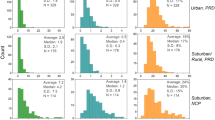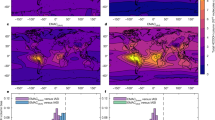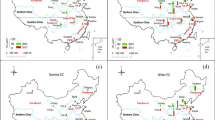Abstract
A detailed understanding of the sources, transformations and fates of organic species in the environment is crucial because of the central roles that they play in human health, biogeochemical cycles and the Earth's climate. However, such an understanding is hindered by the immense chemical complexity of environmental mixtures of organics; for example, atmospheric organic aerosol consists of at least thousands of individual compounds, all of which likely evolve chemically over their atmospheric lifetimes. Here, we demonstrate the utility of describing organic aerosol (and other complex organic mixtures) in terms of average carbon oxidation state, a quantity that always increases with oxidation, and is readily measured using state-of-the-art analytical techniques. Field and laboratory measurements of the average carbon oxidation state, using several such techniques, constrain the chemical properties of the organics and demonstrate that the formation and evolution of organic aerosol involves simultaneous changes to both carbon oxidation state and carbon number.
This is a preview of subscription content, access via your institution
Access options
Subscribe to this journal
Receive 12 print issues and online access
$259.00 per year
only $21.58 per issue
Buy this article
- Purchase on Springer Link
- Instant access to full article PDF
Prices may be subject to local taxes which are calculated during checkout
 ) and number of carbon atoms (nC) for stable organic molecules.
) and number of carbon atoms (nC) for stable organic molecules.
 –nC space of organic aerosol, based upon
–nC space of organic aerosol, based upon  measurements of organic aerosol.
measurements of organic aerosol.

 –nC space, as determined from laboratory studies of oxidation reactions.
–nC space, as determined from laboratory studies of oxidation reactions.
Similar content being viewed by others
References
Kanakidou, M. et al. Organic aerosol and global climate modelling: a review. Atmos. Chem. Phys. 5, 1053–1123 (2005).
Zhang, Q. et al. Ubiquity and dominance of oxygenated species in organic aerosols in anthropogenically-influenced Northern Hemisphere midlatitudes. Geophys. Res. Lett. 34, L13801 (2007).
Kroll, J. H. & Seinfeld, J. H. Chemistry of secondary organic aerosol: formation and evolution of low-volatility organics in the atmosphere. Atmos. Environ. 42, 3593–3624 (2008).
Logan, J. A., Prather, M. J., Wofsy, S. C. & McElroy, M. B. Tropospheric chemistry—a global perspective. J. Geophys. Res. Oceans Atmos. 86, 7210–7254 (1981).
Masiello, C. A., Gallagher, M. E., Randerson, J. T., Deco, R. M. & Chadwick, O. A. Evaluating two experimental approaches for measuring ecosystem carbon oxidation state and oxidative ratio. J. Geophys. Res. Biogeosci. 113, G03010 (2008).
McDermitt, D. K. & Loomis, R. Elemental composition of biomass and its relation to energy content, growth efficiency, and growth-yield. Ann. Bot. 48, 275–290 (1981).
Vogel, F., Harf, J., Hug, A. & von Rohr, P. R. The mean oxidation number of carbon (MOC)—a useful concept for describing oxidation processes. Water Res. 34, 2689–2702 (2000).
Jacob, D. J. Introduction to Atmospheric Chemistry (Princeton Univ. Press, 1999).
Seinfeld, J. H., Erdakos, G. B., Asher, W. E. & Pankow, J. F. Modeling the formation of secondary organic aerosol (SOA). 2. The predicted effects of relative humidity on aerosol formation in the α-pinene-, β-pinene-, sabinene-, Δ3-carene-, and cyclohexene-ozone systems. Environ. Sci. Technol. 35, 1806–1817 (2001).
Pankow, J. F. & Barsanti, K. C. The carbon number-polarity grid: a means to manage the complexity of the mix of organic compounds when modeling atmospheric organic particulate matter. Atmos. Environ. 43, 2829–2835 (2009).
Jimenez, J. L. et al. Evolution of organic aerosols in the atmosphere. Science 326, 1525–1529 (2009).
Heald, C. L. et al. A simplified description of the evolution of organic aerosol composition in the atmosphere. Geophys. Res. Lett. 37, L08803 (2010).
Carlton, A. G. et al. Atmospheric oxalic acid and SOA production from glyoxal: results of aqueous photooxidation experiments. Atmos. Environ. 41, 2588–7602 (2007).
Nguyen, T. B. et al. High-resolution mass spectrometry analysis of secondary organic aerosol generated by ozonolysis of isoprene. Atmos. Environ. 44, 1032–1042 (2010).
O'Brien, R. J., Holmes, J. R. & Bockian, A. H. Formation of photochemical aerosol from hydrocarbons—chemical reactivity and products. Environ. Sci. Technol. 9, 568–576 (1975).
Krivacsy, Z. et al. Study on the chemical character of water soluble organic compounds in fine atmospheric aerosol at the Jungfraujoch. J. Atmos. Chem. 39, 235–259 (2001).
Kiss, G., Varga, B., Galambos, I. & Ganszky, I. Characterization of water-soluble organic matter isolated from atmospheric fine aerosol. J. Geophys Res. Atmos. 107, 8339 (2002).
Altieri, K. E., Turpin, B. J. & Seitzinger, S. P. Oligomers, organosulfates, and nitrooxy organosulfates in rainwater identified by ultra-high resolution electrospray ionization FT-ICR mass spectrometry. Atmos. Chem. Phys. 9, 2533–2542 (2009).
Bateman, A. P., Nizkorodov, S. A., Laskin, J. & Laskin, A. Time-resolved molecular characterization of limonene/ozone aerosol using high-resolution electrospray ionization mass spectrometry. Phys. Chem. Chem. Phys. 11, 7931–7942 (2009).
Wozniak, A. S., Bauer, J. E., Sleighter, R. L., Dickhut, R. M. & Hatcher, P. G. Technical note: molecular characterization of aerosol-derived water soluble organic carbon using ultrahigh resolution electrospray ionization Fourier transform ion cyclotron resonance mass spectrometry. Atmos. Chem. Phys. 8, 5099–5111 (2008).
Mazzoleni, L. R., Ehrmann, B. M., Shen, X. H., Marshall, A. G. & Collett, J. L. Water-soluble atmospheric organic matter in fog: exact masses and chemical formula identification by ultrahigh-resolution Fourier transform ion cyclotron resonance mass spectrometry. Environ. Sci. Technol. 44, 3690–3697 (2010).
Fuzzi, S. et al. A simplified model of the water soluble organic component of atmospheric aerosols. Geophys. Res. Lett. 28, 4079–4082 (2001).
Gilardoni, S. et al. Characterization of organic ambient aerosol during MIRAGE 2006 on three platforms. Atmos. Chem. Phys. 9, 5417–5432 (2009).
Aiken, A. C. et al. O/C and OM/OC ratios of primary, secondary, and ambient organic aerosols with high-resolution time-of-flight aerosol mass spectrometry. Environ. Sci. Technol. 42, 4478–4485 (2008).
Shilling, J. E. et al. Loading-dependent elemental composition of alpha-pinene SOA particles. Atmos. Chem. Phys. 9, 771–782 (2009).
Presto, A. A. et al. Intermediate-volatility organic compounds: a potential source of ambient oxidized organic aerosol. Environ. Sci. Technol. 43, 4744–4749 (2009).
Chhabra, P., Flagan, R. C. & Seinfeld, J. H. Elemental analysis of chamber organic aerosol using the aerodyne high resolution mass spectrometer. Atmos. Chem. Phys. 10, 4111–4131 (2010).
Sun, Y. et al. Size-resolved aerosol chemistry on Whistler Mountain, Canada with a high-resolution aerosol mass spectrometer during INTEX-B. Atmos. Chem. Phys. 9, 3095–3111 (2009).
Chen, Q. et al. Mass spectral characterization of submicron biogenic organic particles in the Amazon Basin. Geophys. Res. Lett. 36, L20806 (2009).
Donahue, N. M., Epstein, S. A., Pandis, S. N. & Robinson, A. L. A two-dimensional volatility basis set: 1. organic-aerosol mixing thermodynamics. Atmos. Chem. Phys. Discuss. 10, 24091–24133 (2010).
Goldstein, A. H. & Galbally, I. E. Known and unexplored organic constituents in the Earth's atmosphere. Environ. Sci. Technol. 41, 1514–1521 (2007).
Atkinson, R. Rate constants for the atmospheric reactions of alkoxy radicals: an updated estimation method. Atmos. Environ. 41, 8468–8485 (2007).
Lambe, A. T., Miracolo, M. A., Hennigan, C. J., Robinson, A. L. & Donahue, N. M. Effective rate constants and uptake coefficients for the reactions of organic molecular markers (n-alkanes, hopanes, and steranes) in motor oil and diesel primary organic aerosols with hydroxyl radicals. Environ. Sci. Technol. 43, 8794–8800 (2009).
MacCarthy, P. The principles of humic substances. Soil Sci. 166, 738–751 (2001).
Reemtsma, T., These, A., Springer, A. & Linscheid, M. Fulvic acids as transition state of organic matter: indications from high resolution mass spectrometry. Environ. Sci. Technol. 40, 5839–5845 (2006).
Graber, E. R. & Rudich, Y. Atmospheric HULIS: how humic-like are they? A comprehensive and critical review. Atmos. Chem. Phys. 6, 729–753 (2006).
Trainer, M. G. et al. Organic haze on Titan and the early Earth. Proc. Natl Acad. Sci. USA 103, 18035–18042 (2006).
Kroll, J. H. et al. Measurement of fragmentation and functionalization pathways in the heterogeneous oxidation of oxidized organic aerosol. Phys. Chem. Chem. Phys. 11, 8005–8014 (2009).
Kessler, S. H. et al. Chemical sinks of organic aerosol: kinetics and products of the heterogeneous oxidation of erythritol and levoglucosan. Environ. Sci. Technol. 44, 7005–7010 (2010).
Pankow, J. & Asher, W. SIMPOL.1: a simple group contribution method for predicting vapor pressures and enthalpies of vaporization of multifunctional organic compounds. Atmos. Chem. Phys. 8, 2773–2796 (2008).
Cappa, C. D. & Jimenez, J. L. Quantitative estimates of the volatility of ambient organic aerosol. Atmos. Chem. Phys. 10, 5409–5424 (2010).
Aschmann, S. M., Atkinson, R. & Arey, J. Products of reaction of OH radicals with α-pinene. J. Geophys Res. Atmos. 107, 4191 (2002).
Edney, E. O. et al. Polar organic oxygenates in PM2.5 at a southeastern site in the United States. Atmos. Environ. 37, 3947–3965 (2003).
Surratt, J. D. et al. Chemical composition of secondary organic aerosol formed from the photooxidation of isoprene. J. Phys. Chem. A 110, 9665–9690 (2006).
Kleindienst, T. E. et al. Estimates of the contributions of biogenic and anthropogenic hydrocarbons to secondary organic aerosol at a southeastern U.S. location. Atmos. Environ. 41, 8288–8300 (2007).
Szmigielski, R. et al. 3-Methyl-1,2,3-butanetricarboxylic acid: an atmospheric tracer for terpene secondary organic aerosol. Geophys. Res. Lett. 34, L24811 (2007).
Paulot, F. et al. Isoprene photooxidation: new insights into the production of acids and organic nitrates. Atmos. Chem. Phys. 9, 1479–1501 (2009).
Claeys, M. et al. Terpenylic acid and related compounds from the oxidation of α-pinene: implications for new particle formation and growth above forests. Environ. Sci. Technol. 43, 6976–6982 (2009).
Acknowledgements
This work was supported by the US Environmental Protection Agency (EPA) Science To Achieve Results (STAR) program (grant R833746 to J.H.K., N.M.D., D.R.W.), the US Department of Energy (DOE: grant DE-FG02-05ER63995), the National Science Foundation (NSF: grant ATM-0904292 to C.E.K., D.R.W. and M.R.C.; grants ATM-0449815 and ATM-0919189 to J.L.J.) and the National Oceanic and Atmospheric Administration (NOAA: grant NA08OAR4310565). K.R.W., H.B., E.R.M. and J.D.S are supported by the Director, Office of Energy Research, Office of Basic Energy Sciences, and Chemical Sciences Division of the US DOE (contract no. DE-AC02-05CH11231), with additional support from the Laboratory Directed Research and Development Program at the Lawrence Berkeley National Laboratory (LBNL). J.D.S. was also supported by the Camille and Henry Dreyfus foundation postdoctoral program in environmental chemistry. This paper has not been subject to peer and policy review by the above agencies, and therefore does not necessarily reflect their views; no official endorsement should be inferred.
Author information
Authors and Affiliations
Contributions
The present work was originally conceived by J.H.K. with C.E.K. and D.R.W., with substantial input by N.M.D., J.L.J., M.R.C., S.H.K. and K.R.W. The ESI data were provided by K.E.A., L.R.M. and A.S.W. (Table 1 and Fig. 2). S.H.K. carried out the combinatorial calculations to produce Fig. 3. Data on the aging of organics (Fig. 4) were collected by J.D.S., S.H.K., J.H.K. and K.R.W. (squalane, triacontane and levoglucosan) and E.R.M., J.D.S., K.R.W. and H.B. (coronene). J.H.K. wrote the paper with input from all co-authors, especially N.M.D., J.L.J., M.R.C. and C.E.K. The Supplementary Information was written by J.H.K., N.M.D., H.B. and E.R.M.
Corresponding authors
Ethics declarations
Competing interests
The authors declare no competing financial interests.
Supplementary information
Supplementary information
Supplementary information (PDF 890 kb)
Rights and permissions
About this article
Cite this article
Kroll, J., Donahue, N., Jimenez, J. et al. Carbon oxidation state as a metric for describing the chemistry of atmospheric organic aerosol. Nature Chem 3, 133–139 (2011). https://doi.org/10.1038/nchem.948
Received:
Accepted:
Published:
Issue Date:
DOI: https://doi.org/10.1038/nchem.948
This article is cited by
-
Combined influences of sources and atmospheric bleaching on light absorption of water-soluble brown carbon aerosols
npj Climate and Atmospheric Science (2023)
-
Chemical Links Between Redox Conditions and Estimated Community Proteomes from 16S rRNA and Reference Protein Sequences
Microbial Ecology (2023)
-
Formation of secondary organic aerosols from anthropogenic precursors in laboratory studies
npj Climate and Atmospheric Science (2022)
-
Secondary organic aerosol formation from mixed volatile organic compounds: Effect of RO2 chemistry and precursor concentration
npj Climate and Atmospheric Science (2022)
-
Using collective knowledge to assign oxidation states of metal cations in metal–organic frameworks
Nature Chemistry (2021)



